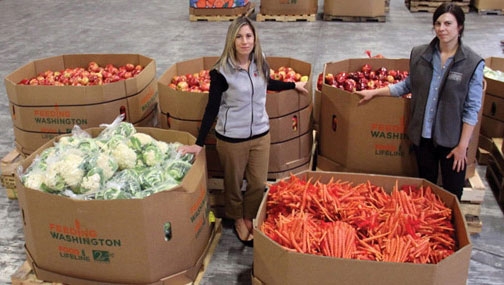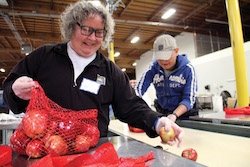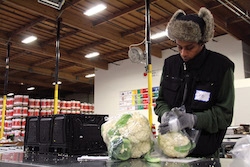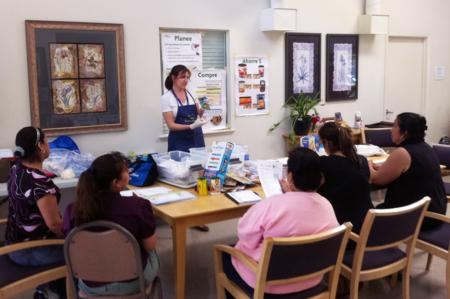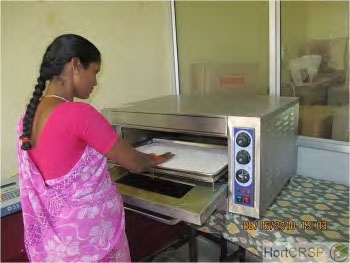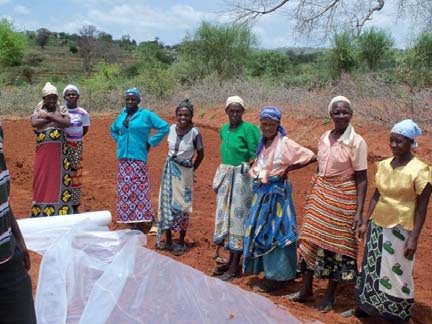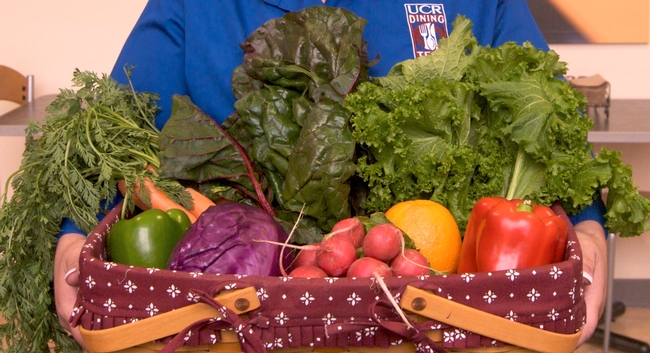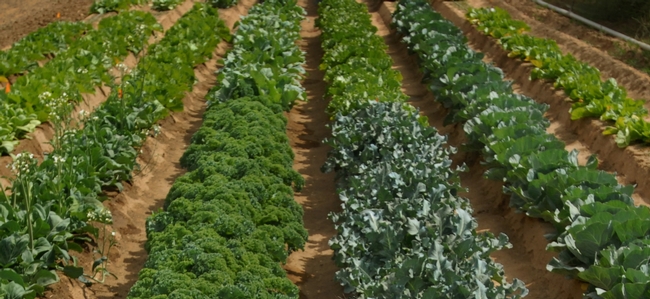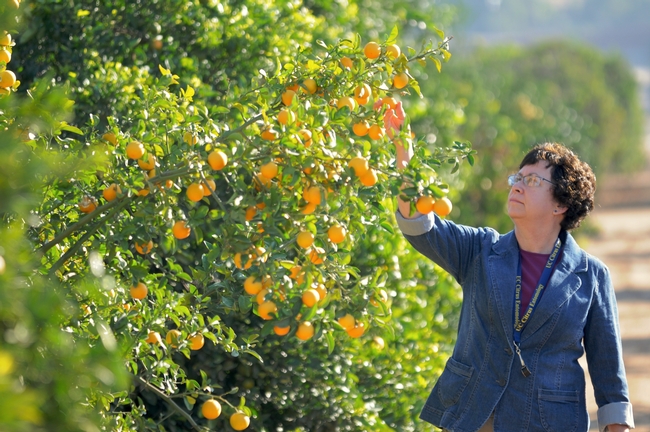Posts Tagged: hunger
Banking on nutrition
It's a drizzly winter morning, and dozens of volunteers at the San Francisco–Marin Food Bank are slowly breaking down a 2,000-pound sack of whole oats into 1-pound bags, their hair tucked back in neat plastic caps. A decade ago, volunteers were more likely to be boxing up canned foods items. Today, 60 percent of everything ferried out of this warehouse is fresh produce. No soda or chips are in sight, and whole grains like these General Mills oats are standard.
For food banks nationwide to move in a similar healthy direction, coordinated efforts must increase at all levels. It will take leadership like that provided by Feeding America, the national food bank network organization; expanded support for nutrition policies at the local and regional levels; and donor efforts to supply more healthful foods. It's a tall order. But with the growing ranks of the food-insecure and obese, there is more pressure — and desire — than ever to provide low-income families with healthful food and create support for food bank nutrition policies to ensure that happens, says Patricia Crawford, UC Cooperative Extension specialist and director of UC Berkeley's Atkins Center for Weight and Health (CWH), a partnership between the College of Natural Resources and the School of Public Health.
“People managing food banks are taking charge and doing the difficult thing of modifying the healthfulness of the food donations they solicit,” says Karen Webb, a nutritional epidemiologist at CWH. “On the one hand, the food banks want an ample supply of foods to hand out, but they're also advocates for people in our most vulnerable population, so the nutritional quality of that food is important.”
There has been progress, which CWH researchers and their colleagues, at the request of the Institute of Medicine (IOM), the health arm of the National Academy of Sciences, have documented in ‘A Movement Toward Nutrition-Focused Food Banking,' an upcoming discussion paper to be released in summer 2014. The report details the evolution of food banking as the number of people served by these organizations jumped a whopping 46 percent from 2006 to 2010, according to Feeding America. Today, 12 percent of the population uses the emergency food system. Driven by increased demand, food banks have shifted from an emergency lifeline to a service filling a chronic need.
While organizations move to provide more healthful food, it's clear that pantry users, or clients, want these foods. A 2011 CWH study asked clients to rank calorie-dense snack-type foods and beverages as well as healthy options by order of preference.
“Food pantry clients ranked the most nutritious foods highest,” says Webb, a co-author of the IOM report. “Those foods are expensive, and they want to receive them. Meat, dairy, and fresh produce are at the top of their list, while soda and candy rank lowest.”
What policy looks like
Getting healthier food into clients' hands requires changes in both policy and practice, but what exactly is a nutrition-driven food policy? Many stakeholders are trying to effect change — food banks and the umbrella groups that support them, organizations and corporations that donate, and state and federal governments — but there are few cohesive policies and common standards to govern how they work together.
To start with, food banks can benefit from formal written guidelines that address the nutritional quality of the foods and beverages that they purchase or acquire from donations, according to the recommendations in the IOM report, whose authors include CWH's Elizabeth Campbell and Michelle Ross, Heather Hudson of the Food Bank of Central New York, and Ken Hecht, formerly with California Food Policy Advocates. A policy should guide the nutritional quality of the food bank's inventory as well as provide data analysis to track how successful the food bank is at distributing foods like produce and limiting unhealthful ones such as processed crackers and chips. Some 56 out of 200 food banks have a policy in place, according to a recent Feeding America survey, but more must be done.
Alameda County Community Food Bank (ACCFB) is a policy model, Crawford says. It established a written policy in June 2013, with the help of the nonprofit anti-hunger group MAZON and CWH. The project, which included several other food banks, was funded by Kaiser Permanente.
“We held focus groups with staff members and agency representatives,” says Jenny Lowe, ACCFB's nutrition education manager. “We wanted to get everyone on the same page. We asked, what are our practices? We'd been following this for a long time, but never wrote it down.”
The food bank's policy is now clear. They purchase fresh fruits and vegetables, low-sugar canned fruits, low-salt canned vegetables, low-fat milk, lean proteins, nut butters, beans, whole grains, packaged meals and soup.
To track the healthfulness of food, they use a computer system that ranks inventory by nutritional level (1, 2, or 3) and employ “traffic light” labeling on the warehouse floor and on order forms. Green is “choose frequently,” yellow “moderately,” and red “sparingly.”
“Green” foods are now more readily available at food banks across California because of the California Association of Food Banks' (CAFB) Farm to Family program, which connects state growers and packers to food banks. In 2011, CAFB, a nonprofit, membership-based umbrella group, sponsored AB152, now a state law, which enables farmers to get a 10 percent tax break on the inventory costs of fruits and vegetables they donate.
CAFB exemplifies how agriculture, advocates, and food banks can work together to create policies that incentivize the support system for healthy diets. Since 2005, the group has increased food bank produce donations by 92 million pounds of fruits and vegetables that might have otherwise been plowed under in the fields. “In California, we have a progressive agricultural community as well as progressive food bank organizers,” Crawford says. “It's that convergence that has made California a model and brought national attention to what we're doing.”
Other positive steps: Feeding America appointed a director of nutrition in 2011, and in 2012, it implemented Foods to Encourage, nutrition guidelines for promoting health—the food bank network's first-time effort at national guidelines. It's also running a pilot program that connects food-insecure clients who have Type 2 diabetes with nutrition, health education, and medical care.
Even with successes like these, there's still a long way to go.
Fresh food, new challenges
Six California food banks participated in a 2010–11 CWH study on inventory trends, funded by the Robert Woods Johnson Foundation. All six had significantly increased the amount of produce they provide to pantries, the study found, but hardy onions and potatoes made up about half of those gains. While the increase in fresh produce was dramatic, getting a variety of vitamins and minerals from different types of produce is key to good nutrition, Webb says.
“Food banks now must tackle the next challenge: adding more colorful yet hardy vegetables, such as bell peppers and broccoli," Webb said.
Part of that challenge is providing better distribution systems to pantries. Many food banks boast state-of-the-art facilities with refrigerated trucks and big walk-in refrigerators, but the pantries they serve are often basement kitchens and church halls with little access to refrigeration or storage. Policy changes must consider how to improve these conditions. For example, ACCFB provides farmers-market style distribution in parking lots to some clients, and both ACCFB and the state of New York help provide pantries with equipment grants to improve facilities.
Sourcing is another hurdle. Although emergency food clients strongly prefer low-fat dairy, lean proteins, and whole grains over soda and other less nutritious foods, it can be difficult for food banks to procure donations that align with these preferences and with nutritional quality guidelines. In 2013, 66 percent of donated foods came from big companies and represented the largest source for food banks, according to Feeding America. Donations of sugary beverages and snack foods have declined substantially, but have not disappeared from the shelves of the six California food banks in the CWH study. In 2010, one California food bank alone distributed over a million pounds—208 million calories—of what Crawford calls “liquid sugar” drinks. “That's a heck of a lot of excess calories going out to the most vulnerable people, who have a greater likelihood to be diabetic and overweight than higher-income folks,” Webb says.
Crawford notes that both the Central New York and Alameda County food banks have successfully implemented nutrition policies without offending donors or losing support.
Moving nutrition forward
In February 2012, anti-hunger leaders convened in Oakland, Calif., to discuss their findings from the 2010–11 Robert Wood Johnson Foundation study. There, CWH and California Food Policy Advocates called for food bank procurement policies that meet or exceed the Foods to Encourage guidelines, which were due to be released later that year.
In the most recent nudge forward, the IOM report recommends that items available through U.S. Department of Agriculture food distribution programs align with key recommendations from the 2010 Dietary Guidelines for Americans. Most food that the USDA supplies to food banks is already healthy, a recent study showed, and the agency is moving quickly to further improve nutritional quality by adding items like whole-grain pastas and brown rice. The report also recommends that food banks and advocates work with donors to find new ways to incentivize nutritious donations.
The IOM report represents a formidable increase in visibility for the issue of food bank nutrition, and Crawford wants to take advantage of the momentum. She's calling for a meeting of key stakeholders to discuss how to keep improvements to the emergency food system's nutritional quality moving forward.
Obesity and diabetes risk continue to plague the nation's health, and food banks will face big challenges in the coming year, including an expected rise in the number of clients as a result of the recent $8.6 billion in cuts to the Supplemental Nutrition Assistance Program — or SNAP, formerly known as food stamps — part of the farm bill passed in February, and as a consequence of California's drought, which is expected to bump up food prices.
“Those of us working in the field of hunger and food insecurity want the best for the people we serve,” Crawford says. “There is a moral imperative to do more than to provide just calories. We must provide foods that will help protect the health of the most vulnerable in our society.”
This article originally appeared in the spring 2014 issue of Breakthroughs, the magazine of the UC Berkeley College of Natural Resources.
World Food Center at UC Davis will tackle global issues
When you think casually of “food,” you may think of your next meal or your favorite food. “World food” may broaden your thinking to include international cuisines, global hunger, or a growing population. But the academic fields related to food are numerous. Food is one of life’s basic necessities, and along with its associated issues it is essential to the health and well-being of everyone, whatever their locale, education, or income level.
The new World Food Center at UC Davis will take on a broad purview related to food, including sustainable agricultural and environmental practices, food security and safety, hunger, poverty reduction through improved incomes, health and nutrition, population growth, new foods, genomics, food distribution systems, food waste, intellectual property distribution related to food, economic development and new technologies and policies.
With rapid global population growth occurring on smaller amounts of arable land, coupled with the expected impacts of climate change on food production, understanding the sustainability of food into the future is critical.
The new center’s website notes, “The World Food Center at UC Davis takes a ‘big picture’ approach to sustainably solving humanity’s most pressing problems in food and health. By bringing together world-class scientists with innovators, philanthropists and industry and public leaders, the center will generate the kind of visionary knowledge and practical policy solutions that will feed and nurture people for decades to come.”
In establishing the World Food Center, UC Davis Chancellor Linda Katehi said, “We did this to fully capitalize on our depth and expertise as the world’s leading university for education, research and scholarship on all aspects of food, but especially the nexus between food and health.”
UC Davis is the top-ranked agricultural university in the world, and California is the major producer of vegetables and fruit in the nation. Tom Tomich, director of the Agricultural Sustainability Institute and professor in the Department of Environmental Science and Policy at UC Davis, says of the World Food Center’s location at UC Davis, “There’s no place else that has the right mix of educational programs, research facilities, and the engagement with the state.”
The major academic disciplines surrounding food are found at UC Davis — agriculture, the environment, medicine, veterinary medicine, engineering, social and cultural sciences, and management. More than 30 centers and institutes at UC Davis will be pulled together through the World Food Center. The combination of scholarship, leadership, and partnerships at UC Davis has already established the campus as a center for food-related science and outreach. This new center will reinforce that strength and broaden the university’s ability to tackle tough global issues related to food.
Although the founding director of the center has yet to be named, Josette Lewis, Ph.D., was recently appointed as the associate director of the World Food Center. Her background on international research and development for the U.S. Agency for International Development, and director of its Office of Agriculture, honed her skills to take on the World Food Center. It was at US AID that she worked on a major global hunger and food security initiative, establishing her expertise on issues related to global agricultural development and food security.
As the new World Food Center becomes fully developed, it will be well-positioned on campus to continue to solve the major global issues related to food that are a hallmark of UC Davis.
Additional information:
- World Food Center website
- UC Davis video on the World Food Center
- Key facts
- UC Davis Dateline article
- Sacramento Bee article
Stretching food dollars to reduce hunger
To supplement their food supply, Californians can turn to the CalFresh program, which was formerly known as food stamps. The federal program is called the Supplemental Nutrition Assistance Program, or SNAP.
To help CalFresh participants stretch their food dollars and maintain a nutritious diet, the University of California’s CalFresh Nutrition Education Program offers a series of four workshops called "Plan, Shop, Save and Cook." In a follow-up survey, UC Cooperative Extension advisors Dorothy Smith and Marcel Horowitz found that one-third of the 1,373 people who participated in the workshops said they weren’t running out of food by the end of the month as often.
In the first workshop, people learn the benefits of preparing a balanced meal plan. To do this, they discuss building meals around store specials, foods on-hand and leftovers, while including family favorites.
During the second workshop, participants read the nutrition labels on foods and learn how to make the best nutritional choices while shopping.
In the third workshop, UC CalFresh instructors show the participants how to determine the least expensive options for the items on their grocery list. For example, if buying beef, chuck roast is cheaper and contains less fat than sirloin. Unit pricing, bulk purchases, generic brands, convenience items, alternative protein sources and preventing spoilage and waste are things to consider when choosing food products.
During the final workshop, the participants prepare and taste dishes made with low-cost nutritious foods. They put their new knowledge into practice by creating a one-week meal plan.
In San Luis Obispo and Santa Barbara counties, UC CalFresh have teamed up with local food banks to encourage families to eat more fruits and vegetables. Using fresh produce from the food banks, UC CalFresh nutrition representatives prepared fruits and vegetables in healthful dishes, which were tasted by participating families.
UC CalFresh is showing Californians that nutritious and tasty meals don’t have to cost a lot.
Addressing nutrition and poverty through horticulture
Nutrition, food security and sufficient family incomes are challenges in many parts of the world. Half the world’s people live in rural areas in developing countries. Because hunger and malnutrition are often linked to poverty, providing economic opportunities through horticultural production not only helps family incomes, but also addresses food security and nutrition. Training women to produce and market horticultural crops in the developing world also helps provide a much-needed income stream for families with children.
UC Davis is addressing food security and economic development in Africa, Southeast Asia, Central America, and elsewhere, by coordinating an international horticulture program. The Horticulture Collaborative Research Support Program (Hort CRSP; pronounced "hort crisp") is one of 10 CRSP programs that focus on global food production and solving food and nutrition problems in developing countries. UC Davis leads the Hort CRSP, with funding support from the U.S. Agency for International Development (USAID).
Examples of projects conducted by researchers and educators throughout the world include:
- Inexpensive cold storage systems in rural, developing areas to prolong food longevity; see page 2
- Concentrated solar drying of fruits and vegetables in East Africa; see page 3
- Improving safety and quality of tomatoes in Nigeria; see page 3
- Smallholder flower production in Honduras for export markets; see page 3
The overarching goals of the Hort CRSP are to reduce poverty and improve nutrition and health of the rural poor, while improving the profitability and sustainability of horticulture in the developing world. Priorities in the Hort CRSP include gender equity, sustainable crop production, postharvest technology, food safety, market access, and financing. The program awards research funding in the U.S. and abroad to:
- Realize opportunities for horticultural development
- Improve food security
- Improve nutrition and human health
- Provide opportunities for income diversification
- Advance economic and social conditions of the rural poor, particularly women
Dr. Elizabeth Mitcham, UC Cooperative Extension specialist in the Department of Plant Sciences at UC Davis and director of the Hort CRSP, notes, “By harnessing the research, training, and outreach expertise of the land-grant universities in the U.S. to work with partners in developing countries, we can improve horticultural capabilities in much the same way that the land-grant system helped revolutionize American agriculture.”
In the three years since the program’s inception, several projects have been completed, and many are ongoing. The program’s website offers a plethora of information, along with newsletters that highlight individual projects.
The program also has a YouTube channel, with videos on Hort CRSP projects. Some of the videos are about projects that are especially important in developing countries, including:
- The TRELLIS project — bringing together graduate students and in-country development organizations; YouTube link
- Using cell phones to give real-time information to growers in rural areas of India; YouTube link
- Inexpensive cultivation practices for smallholder farmers; YouTube link
- Indigenous products increase incomes in Ghana; YouTube link
- Saving indigenous crop seeds in Southeast Asia for resource-poor farmers; YouTube link
UC Davis, ranked first in the U.S. on research related to agriculture, food science and nutrition, and plant and animal science, is positioned to serve global needs related to food and nutrition. Of the 10 CRSP programs administered by USAID, two of the programs are based at UC Davis — the Hort CRSP program, and the BASIS CRSP, which was highlighted in a recent Food Blog post and addresses financial issues related to agricultural productivity.
Solving the 2050 Hunger Game
The world population is more than seven billion, and by 2050 that number is set to rise to nine billion — an increase of 50 percent since 2000. Can we possibly feed so many people?
Yes, according to Prabhu Pingali, who was invited to UC Riverside last week by the One Health Center to give a talk. Pingali, the deputy director of the Agriculture Development Division of the Bill & Melinda Gates Foundation, has more than three decades of experience in the field of agriculture. His hour-long talk focused on how nine billion people on the planet can be fed.
He explained that agriculture was on no one’s agenda from 1988 to about 2006-2007. But today it is back. “I am in the right profession,” he said, smiling.
He said the world experienced a sharp increase in food prices in 2008 due to a “perfect storm” — a rapid demand for food quantity and quality (in terms of diversity) and a high volatility in food prices — and a large group of people adopted a pessimistic view of the world’s food production thereafter. The world will not be able to feed itself, they warn.
“But we’ve been here before and we have come out of it,” said Pingali, who has authored ten books and more than 100 refereed journal articles and book chapters on food policy, technological change, productivity growth and resource management in the developing world. “Actually, things are not as bad as you think they are. I take a more positive view.”
The audience sat up straight, ears pricked up, eyes trained firmly on Pingali’s slides.
He explained that in 1963 the world experienced a massive food deficit but that by 1970 the overall food outputs matched population growth rates, with Southeast and East Asia showing the fastest rise in productivity.
“Only in sub-Saharan Africa was there a decrease in productivity,” he said. “Technology made the change possible. But technology cannot do it alone. If government support had not also taken place, we would not have seen a change.”
Looking ahead
Pingali’s slides showed how on the demand side in Asia and Latin America the per capita consumption of staple grain is declining rapidly. As incomes increase, he said, the per capita consumption of wheat and corn decreases and diets get diversified, with people seeking higher quality food.
He predicted more consumption of meat, milk and dairy products in the future. In East Asia, meat consumption will be about 80 kg per person per year in 2050 (in 1975, it was less than 20 kg per person per year; in 2000 it was about 40 kg per person per year). Further, in the future much biofuel will be from cellulosic technology and other forms of waste, not grain.
But what about land area? Will there be any left to produce food for two billion more people? Pingali thinks so. He said overall 4.2 billion hectares of land on the planet are suitable to cultivation; of this area, only about 1.7 billion hectares are already under cultivation.
“We will see an intensification of land already under cultivation, that is, growing a crop more frequently on the same land,” he said. “One reason these areas are currently not productive is poor soil — acidity, erosion, sloping lands, low organic matter and low nitrogen.”
Pingali predicts water scarcity will be a growing constraint. He explained that currently enormous wastage of water occurs in many parts of the world, but that water use can be better managed.
According to him, we can expect that the following steps will be needed to manage future food production: changing cropping patterns; improved tolerance to drought and submergence; increased use of hybrids; and better land and water management practices.
What should we do?
Pingali thinks we should keep the focus on agriculture and invest in smallholder productivity growth.
“Technology, including biotechnology, will be an important part of the solution,” he said. “Policies that enable and encourage smallholder productivity growth are crucial. We need to pay particular attention to stress-prone environments and invest in a long-term strategy for biofuels that does not rely on increased use of food grains.”
Pingali predicts Malthus will be proven wrong again because of “our ingenuity and our ability to deal with resource scarcity through technical innovation and focused policy change.”
At the end of his talk, several hands went up and a vibrant Q&A ensued. Unfortunately, I never got to ask my question, time being up: “Dr. Pingali, how would your talk today change for feeding a world population of 15 billion?
Not by much, I suspect he’d have said with confidence and no hesitation, his unstoppable optimism swelling further in the room.



